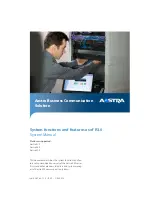
Operations Manual
SV-2003-X2 Server
Part Number: 1006446
Page 21 of 72
Version 1.0. 10/30/07
For information on replacing or upgrading your
system memory, refer to “Adding and
Replacing System Memory on page 58.”
4.5 TAG Approved BIOS
The BIOS (basic input/output system) is the
program stored on the CMOS that the server's
microprocessor uses to get the system started
after you turn it on. The BIOS also manages
data flow between the computer's operating
system and attached devices such as the hard
disk, video adapter, keyboard, and mouse.
CAUTION:
The BIOS installed on your
server was loaded and tested with all the
devices initially installed in your system. If
you desire to have the BIOS updated,
consult TAG technical support in advance
as updates to your approved BIOS may
cause your system to become unstable or
inoperable.
4.5.1 Common BIOS Settings
Printer Parallel Port-Uni., Bi-directional, Disable, Enable, ECP, EPP
4.5.1.1 Printer Parallel Port Uni., Bi-Directional, Disable,
Enable, ECP, EPP.
Settings in the CMOS enable you to configure
a parallel port to use Enhanced Parallel Port
(EPP) or Enhanced Parallel Port (ECP). ECP.
EPP and ECP are bi-directional standards,
operate in 8-bit, and allow data transfer speed
of approximately 2 MB/s. Some of the main
differences are that ECP supports Direct
Memory Access (DMA) and data compression,
which enables higher transfer rates.
It is also possible to completely disable the
parallel port in the BIOS. Most BIOS' allow you
to set the DMA channel, when the port mode is
set to ECP.
















































